
La Belle Epoque is a barge of the Belgian spits category. She was built in 1930 to carry (mainly) timber. Renovated in 1995, she operates as a hotel barge on the Burgundy Canal in central France.

Nymphea is a classic Dutch style river barge with shallow draught. She was built in 1921 to carry cargo along the canals of Europe and presently serves as a hotel barge in France.

The Brussels–Charleroi Canal, also known as the Charleroi Canal amongst other similar names, is an important canal in Belgium. The canal is quite large, with a Class IV Freycinet gauge, and its Walloon portion is 47.9 kilometres (29.8 mi) long. It runs from Charleroi (Wallonia) in the south to Brussels in the north.
Savoir faire may refer to:

Anjodi was built to carry freight on the waterways of the Netherlands, Belgium and France but has been converted to a hotel barge.

A hotel barge is a barge that has been built or converted to serve as a hotel or other kind of lodging. Hotel barges are generally found on rivers and canals in Europe, and may be used for river cruises or permanently moored in one place.

Enchanté is a Belgian-built barge of the spits category, originally named Maria, converted into a hotel barge. She is one of around 50 hotel barges operating on the French waterways.

The L'Impressionniste was built in 1960 in Belgium and is a spits barge with a Dutch luxe motor-style bow. The overall hull shape of the barge is a marriage of the French and Dutch barge building influences. She was converted to a hotel barge in 1996. L'Impressionniste is owned and operated by European Waterways and sails on the Canal de Bourgogne in France.
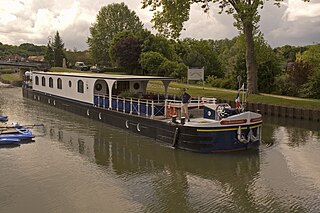
Renaissance was built in Belgium in 1960 as a standard péniche barge to carry cargo along the canals of Europe. Her original cargo was grain and iron ore. She presently serves as a hotel barge, owned and operated by European Waterways. She is one of around 60 barges offering luxury cruises on French waterways.
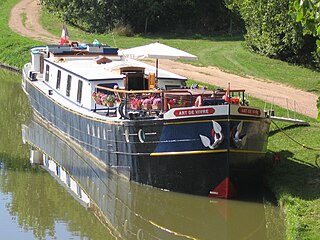
The L'Art de Vivre was built in 1917 in Deptford, England, as a cargo barge but currently serves as a luxury hotel barge owned and operated by European Waterways. She is one of around 60 hotel barges operating on European waterways, mostly on the smaller French canals.

The La Dolce Vita was built in 1897 in Groningen, Netherlands. She originally served as a cargo barge in the Netherlands. She presently serves as a hotel barge, owned by Giampaolo Friso.

Rosa is a French hotel barge of Dutch origin. Since 1990 she has been offering cruises to international tourists on the Canal de Garonne in the Nouvelle Aquitaine region of South West France. The waterway authority Voies Navigables de France reported in 2014 that there were around 80 hotel barges operating on the inland waterways. They keep alive the tradition of the boatmen (mariniers) whose numbers have declined in number from thousands in the post-World War II years to just a few hundred today.
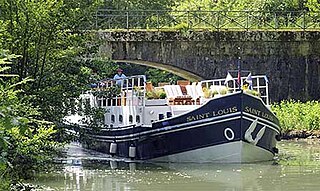
Saint Louis is a Luxemotor hotel barge, on the Canal de Garonne in South West France.

A péniche is a steel motorised inland waterway barge of up to 350 tonnes' capacity. Péniche barges were built to fit the post-1880s French waterways and the locks of Freycinet gauge. They are visually similar to a Dutch barge, but built to different specifications.
Les Bateaux Belmond is a group of seven canal barges or péniche-hôtels that are part of the Belmond collection of around 50 international hotels, trains and river cruises. Formally known as Afloat in France, the barges offer cruises on canals and rivers in the French regions of Burgundy, Franche-Comté, Saône, Provence, Vallée du Rhône, Midi-Pyrénées and Camargue, while the Alsace and Champagne regions are added in 2018. The barges carry up to 12 passengers. The barges visit towns and cities including Dijon, Besançon, Carcassonne, Arles, Nancy and Strasbourg. There are stops at countryside sites of interest en route.
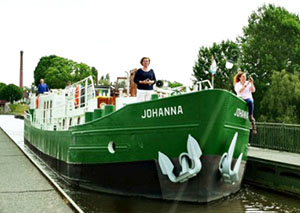
Johanna is a former working barge (péniche) of Freycinet dimensions, after the French minister of transport Charles de Freycinet who gave his name to an Act of Parliament in 1879, establishing a standard for French canals: they were to accommodate barges of 38.50 by 5.05m, carrying 250 tonnes to a draught of 1.80m. Thousands of such vessels were in operation on the network until the 1960s, when the decline in commercial traffic started. Many péniches were converted by their operators into permanent homes. Johanna is one of around 60 hotel barges offering cruises on European waterways, most of them in France.
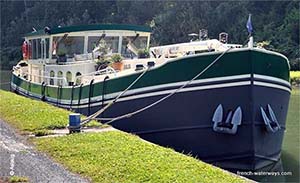
Aslaug is a replica Luxemotor Dutch barge built in 2005/2006 to operate as a hotel barge on the French waterways. She is one of around 50 hotel barges operating in France, and currently offers holiday cruises on the river Somme, between Saint-Valéry-sur-Somme and Péronnes. She is the only hotel barge operating on this waterway. Aslaug was named after a queen of Norse mythology.
Le Phénicien is a converted barge (péniche) of Freycinet dimensions, fitted out and operated as a hotel barge in Southern France. She is one of a fleet of barges of different dimensions operated throughout the European network of smaller waterways, mostly in France. According to the waterway authority Voies Navigables de France, there are around 80 barges operating as hotel boats.
La Reine Pédauque is a former freight-carrying barge of Freycinet type, converted into a hotel barge and operating on the Canal de Bourgogne in central France. She is one of around 60 barges offering cruises on the smaller waterways of Europe, mainly France.















